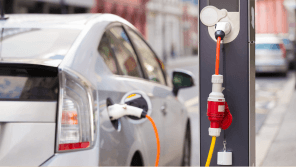New guidelines on home EV charging rate
.
Tracking the cost to charge an electric vehicle at home to determine your income tax deductions can be challenging. Fortunately, the Australian Taxation Office (ATO) has introduced new guidelines to simplify this process. This article will explain these guidelines and how to apply them for income tax and Fringe Benefits Tax (FBT) purposes. Understanding the ATO’s guidelines helps you determine the cost to charge electric cars, whether you use home charging stations, public charging stations, or even DC fast charging. You can now use methods like the shortcut method or logbook method to calculate electricity costs for EV charging. These guidelines also cover charging costs for plug-in hybrid vehicles and electric motorcycles.ATO’s new guideline for EV charging costs
The Australian Taxation Office (ATO) has introduced a new Practical Compliance Guide (PCG) for calculating EV charging costs. Effective from 1 April 2022 for Fringe Benefits Tax (FBT) and from 1 July 2022 for income tax, this guide introduces a 4.2 cents per kilometre rate to simplify the calculation of electricity costs for charging electric vehicles (EVs) at home.
Simplifying EV expense management
This new shortcut method makes it easier for both employers and individual taxpayers to manage their EV-related expenses. By using this rate, you can determine the cost to charge electric cars, plug-in hybrid vehicles, and other EVs without needing detailed records of every charging session. This method also simplifies the tracking of expenses for FBT purposes, helping EV drivers and businesses calculate and manage costs more efficiently.
Benefits of the 4.2 Cents per kilometre rate
The 4.2 cents per kilometre rate is especially beneficial for owners of popular electric cars like Tesla. It ensures accurate accounting of electricity costs without the need for complex calculations or maintaining a logbook. This approach also considers various charging locations, including home charging stations, public charging stations, and systems powered by solar panels.
Key changes in the ATO’s final PCG for EV charging costs
Extension of transitional rules
The ATO has extended the transitional rules to allow odometer readings to include the start of the 2023/24 FBT and income years, even if these readings were not initially recorded. This extension provides more flexibility for taxpayers who might have missed recording their odometer readings at the beginning.
Combination of calculation methods
The new guidelines now allow for combining the cents per kilometre method with actual external costs, provided you can determine the percentage of the vehicle’s charge based on the type of charging location. This change enables a more accurate calculation of electricity costs for charging EVs, considering various charging locations such as home charging stations, public charging stations, and other external charging networks. This approach helps ensure precise tracking of charging costs for electric cars, plug-in hybrid vehicles, and other EVs.
Simplifying home EV charging with the shortcut method
The 4.2 cents per kilometre rate is very handy when it’s difficult to separate the electricity used for charging your electric vehicle from the overall household electricity costs. This method can be chosen by both employers and individual taxpayers on a per-vehicle basis, and you can change your choice annually.
By using this method, you ignore all other actual charging costs, including those from commercial charging stations. This makes calculating the electricity costs for charging your electric car simpler, as you don’t need to keep detailed records of each charging session. This shortcut method is ideal for EV drivers who charge their vehicles at home but find it challenging to distinguish between the EV charging rate and the total household electricity consumption.
Fringe Benefits Tax (FBT) considerations for EVs
Even if an Electric Vehicle (EV) qualifies as an FBT-exempt car, employers must calculate the ‘notional’ taxable value for the employee’s reportable fringe benefits amount. For non-exempt EVs, the taxable value of the fringe benefit must be determined.
The electricity costs of the EV can be included in various ways:
- Operating Cost Method: Include the total operating expenses, such as the cost to charge the EV at home or at public charging stations.
- Employee Contributions: Applicable for both the Operating Cost and Statutory Rate methods, incorporating costs incurred at home charging stations, DC fast charging locations, and other charging networks.
- Residual Fringe Benefit: Consider the taxable value of a residual fringe benefit, factoring in the EV charging rate and battery capacity.
- Expense Payment Fringe Benefit: Include the taxable value of any EV costs reimbursed or paid by the employer, such as electricity costs from commercial EV charging stations or costs related to charging plug-in hybrid vehicles.
This approach ensures that all relevant costs, including charging costs at various locations such as home charging stations, public charging stations, and solar-powered setups, are accurately accounted for.
Employers must consider these costs whether the vehicle is fully charged at home, uses DC fast charging, or charges at any other EV charging station.
Income tax deductions for EV charging
Individual taxpayers can claim the electricity costs for charging their Electric Vehicles (EVs) as a tax deduction in their personal income tax return for any portion incurred in generating assessable income. This applies if you use the logbook method and own or lease the car in your name (not salary packaged).
Methods for claiming deductions
You can choose between two methods for claiming your EV’s electricity costs:
- 4.2 Cents per Kilometre Method: As prescribed by the Practical Compliance Guide (PCG) 2024/2, this method simplifies the process by allowing you to claim 4.2 cents per kilometre without needing detailed records of each charging session.
- Actual Electricity Expenditure: Alternatively, you can keep receipts and claim the actual electricity costs incurred from charging your EV at home, public charging stations, or other locations.
It’s important to note that if you use the general cents per kilometre method for car deductions (currently 85 cents/km), the electricity costs are included within this rate and are not separately deductible. This method covers all vehicle expenses, including fuel, maintenance, and electricity costs, making it simpler but potentially less precise for those with significant EV charging expenses.
Record keeping requirements for EV charging
Maintaining thorough records for five years is essential for complying with Fringe Benefits Tax (FBT) and income tax requirements. If you’re using the PCG, you need to keep odometer readings at the start of each year to calculate the kilometres travelled. If initial odometer records are missing, reasonable estimates based on service records or similar data can be used.
Specific documents to keep
- Logbooks: Required for both the FBT Operating Cost method and the income tax logbook method.
- Electricity Bills: Proof of electricity costs from your home, unless solar panels cover all charging needs, in which case the 4.2 cents per kilometre method can’t be used.
- Charging Costs: Detailed records of charging costs at home, public charging stations, and other EV charging locations.
Simplifying with the shortcut method
The shortcut method (4.2 cents per kilometre) simplifies expense tracking but still requires accurate record-keeping to meet Australian government standards. This includes keeping receipts and tracking electricity costs for EV charging to ensure correct deductions and efficient tax management.
Income tax deductions
Using the logbook method for income tax allows you to claim electricity costs for charging your EV if the car is owned or leased in your name and not salary packaged. This method helps track and deduct costs for charging at various locations, ensuring accurate and efficient tax reporting.
Plug-in Hybrid Vehicles
The 4.2 cents per kilometre rate under the shortcut method is exclusively for fully electric vehicles. Currently, the Australian Taxation Office (ATO) does not provide specific guidelines for electricity costs related to plug-in hybrid vehicles, electric motorcycles, or electric scooters. Therefore, owners of these vehicles must find other ways to calculate their charging expenses.
Alternative calculation methods
For plug-in hybrid vehicles, the shortcut method cannot be used to calculate charging costs incurred at home, public charging stations, or other EV charging locations. The same restriction applies to electric motorcycles and electric scooters, as the current ATO guidelines do not include provisions for these types of vehicles.
Tracking and managing costs
Drivers of plug-in hybrid vehicles and other electric vehicles need to maintain detailed records of their charging costs. This involves keeping receipts and tracking electricity usage at different charging locations to accurately manage and report expenses, in the absence of specific ATO guidelines.
Next step is to contact TMS Financials
TMS Financials provides you with a team of experienced professionals that help you achieve your financial goals through smart tax structures and strategic financial structuring. We’re a one-stop shop for all financial needs and pride ourselves on building strong partnerships with our clients.
Book a free financial health review to see the difference we can make in your financial future.
Book a Consultation
Disclaimer
Related Articles

Minimising Capital Gains Tax on investment property guide
Minimising Capital Gains Tax on investment...

Division 7A compliance: Essential updates for business owners in 2025
Division 7A compliance: Essential updates for...

How to save FBT costs with your next Electric Vehicle
How to save FBT costs with your next Electric...
Contact Us
Tax Insights & Business Advice
Receive only the guidance that matters. Subscribe now for personalised tips and expert advice, directly suited for you and your business.

